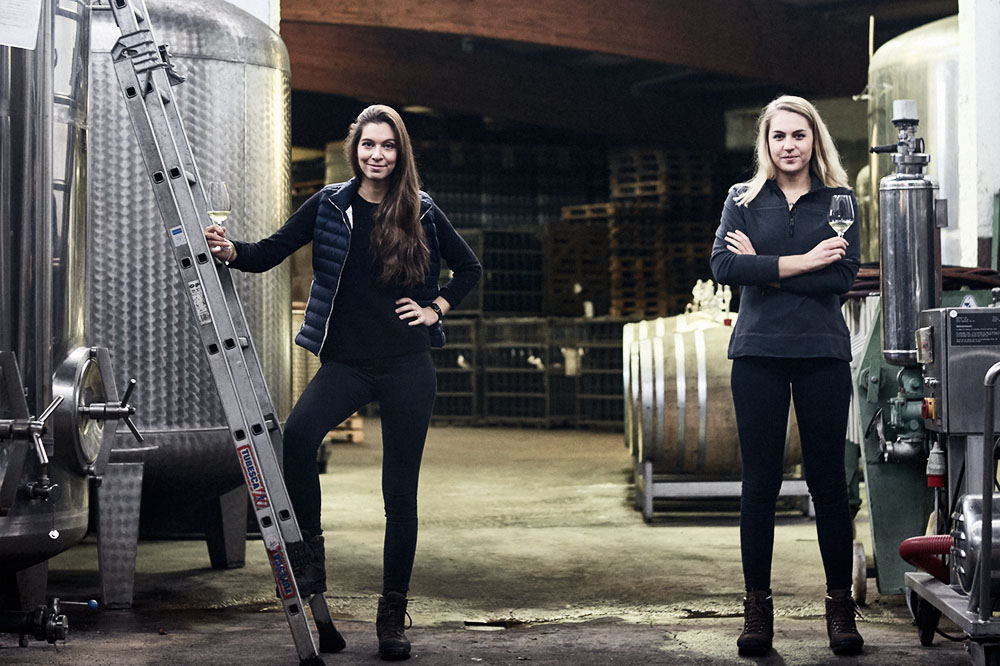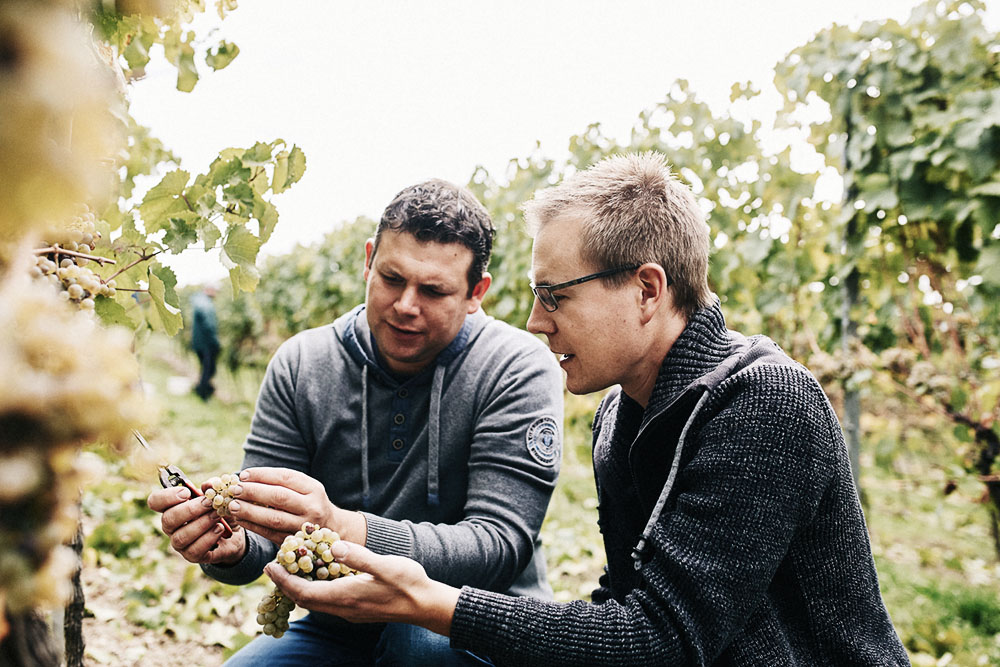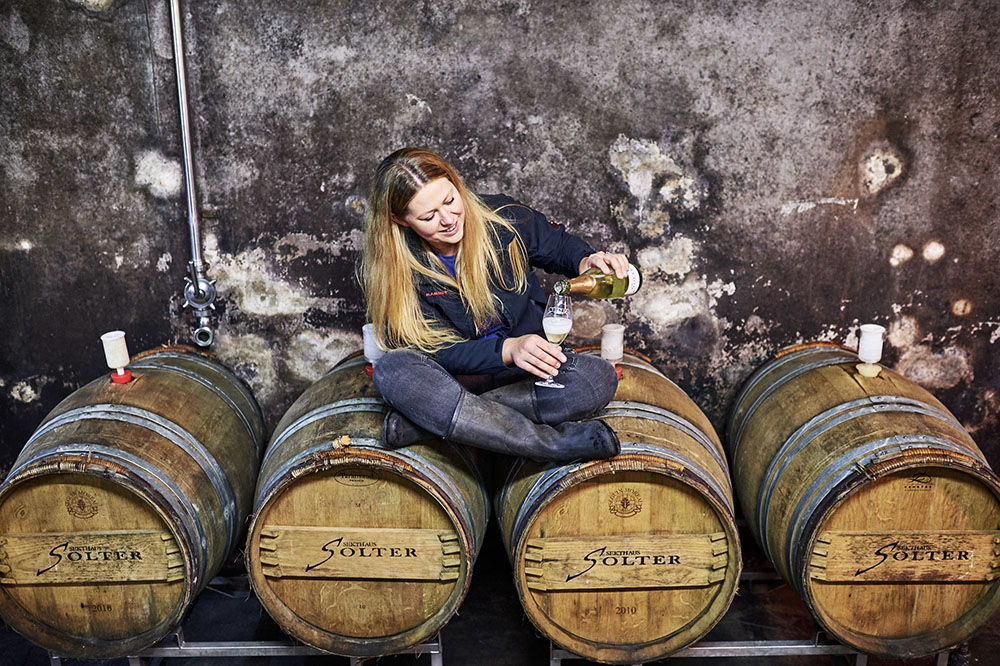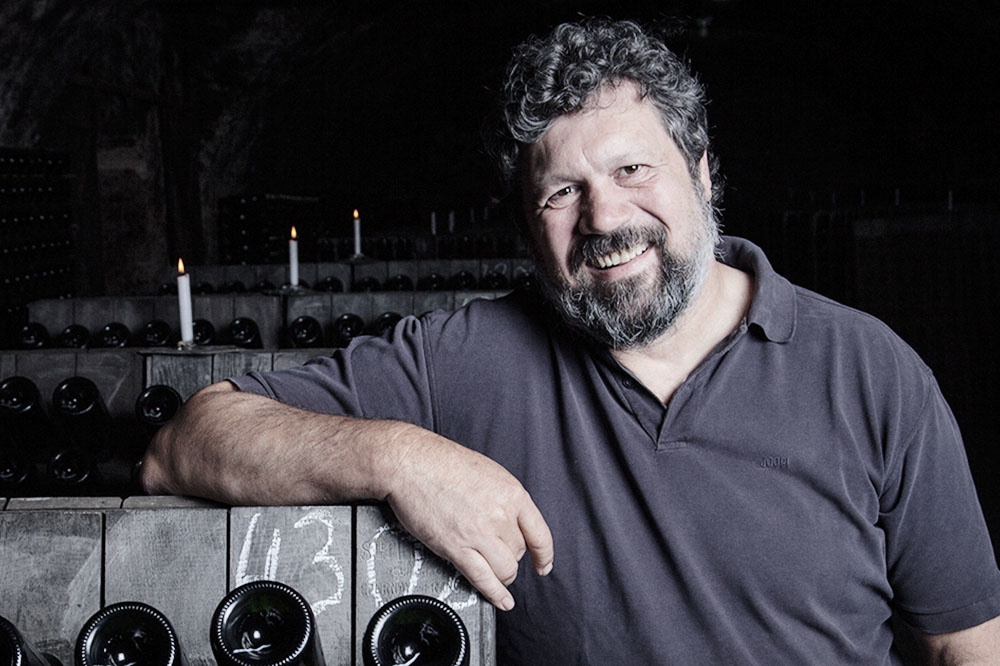
German wine consumers drink a lot of Sekt, German sparkling wine, but most of it is inexpensive, dry to off-dry bubbly. But it can be confusing. You see, Deutscher Sekt can be made from all local grapes or from a blend of domestic and foreign grapes, or even 100 percent foreign-base wine. As an example, you’ve probably all had a glass of Henkell Trocken.
But there is a significant amount of quality, bottle-fermented sparkling wine being made in Germany from local grapes. Officially called Winzersekt or Qualitätsschaumwein, the grapes have to come from the winery’s own vineyards — although they can farm out production (riddling, disgorging, bottling, et cetera). Many refer to it simply as Schaumwein, with schau meaning “show” and schaum translating as “foam” or “froth.”
For Sekt producers, 2018 was a strange vintage. It was very hot and dry, resulting in a historic early harvest, taking place in August for the first time ever. They were harvesting at Raumland during our visit to their estate in Flörsheim-Deidesheim, in Rheinhessen. Raumland is referred to by some as “The God of Sekt.” Indeed, their 2012 NV Brut was recently named the best Riesling Sekt in Germany. The winery is relatively small, producing around 50,000 litres from 10 hectares of estate vineyards, 100 percent organic since 1990.
Once you’ve tasted god’s wines, one wonders how the other Sekthäuser compare.
On a visit to Strauch, a family-run operation in nearby Osthofen, it was clear that quality Schaumwein is not just the property of the Gods.
In 2011, Isabel Strauch-Weissbach and her husband, Tim Weissbach, took over her parents Sekthaus. They produce a range of sparkling wines, making approximately 250,000 to 300,000 bottles per year — including those for other wineries — from a range of grapes, including Pinot Blanc, Riesling, Sylvaner, Chardonnay, Pinot Noir and Pinot Meunier. Their style is more straightforward and less complex (thus less expensive) than Raumland’s.
Going through the region tasting these top-level traditional method sparkling wines showed that Germany makes bubbly at the highest level, equal to top versions from the rest of the world, and available at fair prices. The variety is impressive, owing to different philosophies regarding the use of malolactic fermentation with some wines and not others, and using Riesling at 100 percent or blending it with Pinot family grapes. There is no question that some producers are making wines from Champagne varieties that taste just like Champagne.
Once you’ve tasted god’s wines, one wonders how the other Sekthäuser compare.
Raumland Tradition Riesling Brut 2012 ($26)
Judged Germany’s best Riesling Sekt this year. A fresh and fruity bubbly but with nice, toasty notes. A great example of Champagne-like Schaumwein at a great price. Uses malolactic for creaminess and an early pick for acidity. 6 g/l sugar. Terrific value.
Raumland Cuvée Katharina Brut Nature 2013 ($30)
Judged best Burgundy grape Sekt in Germany this year. A blend of Pinot Noir and Pinot Meunier with zero dosage. Fresh and crisp in style, even with full malolactic. Partially fermented in old and new oak barrels. Incredible value.
Strauch Riesling Extra Brut 40 Monate 2012 ($30)
A creamy bubbly, with lots of stone-fruit flavours and good length. Even though it’s Riesling, one could mistake it for Champagne. Strauch normally uses malolactic, except in really warm vintages, such as 2018.
Streit Grande Cuvée 2014 ($45)
One of those rich, soft, heavily autolytic sparklers. A blend of Pinot Noir, Chardonnay and Pinot Meunier, it has great texture and length. They disgorge 500 bottles approximately every 6 months. This bottle was disgorged in October 2017 and tasted in August 2018.
Bardong Chardonnay Brut 2014 ($45)
A special wine from grapes grown on the 23 ha Mariannenaue vineyard, on an island in the Rhine, 10 km east of Bardong. It has distinct apricot notes and fresh acidity. It’s very elegant. We also tried the 2007 vintage, which had complex notes of dried fruit and nuts, but still had life.
Bardong Erbacher Honigberg Riesling Extra Brut 2012 ($28)
Bardong only makes single-vineyard, single-grape wines, and this Riesling really shows its heritage. It is very dry, with only 3 g/l dosage, and is very much in the crisp style, with zero malolactic. It spent 6 years on the lees, though, which gives it a light citrus pastry note.
Bardong Erbacher Honigberg Reserve Brut 1998 ($26)
Perhaps it is the fact that they use no malolactic, but this still has a lot of life. Lightly golden in colour, it has pleasant apple aromas and flavours, and is not overly autolytic or oxidative.
Solter Roseneck Single Vineyard Riesling 2012 ($32)
A warm year so this wine has a roundness you don’t normally expect from Riesling, especially since they use no malolactic. It is fresh, but has a long, tasty finish. Solter’s all-women winemaking team makes bubbly for 50 other wineries in addition to their own.
Vaux Rosé Réserve 2015 ($40)
100% Pinot Noir, but from a selection of different clones. Made with 20% malolactic, and 30% aged in old oak. It has an attractive red fruit nose and is a bit toasty, with full texture. A bit creamy, but with firm acidity. Aged 27 months on the lees.
Vaux Erbacher Marcobrunn Riesling 2014 ($60)
A famous single-vineyard bubbly from Riesling, grown about 5 km west of the winery, close to the river in Hattenheim, on rich, weathered limestone. This is a rich, leesy, developed wine, with nutty character and longer lees aging, and is recommended to be served with slow-cooked meats. It’s lovely and complex.
Vaux Assmanshäuser Pinot Noir 2014 ($40)
Those of us who scoff at sweet, oaky sparkling Shiraz can turn to this fabulous red bubbly for a much more satisfying experience. It’s a dry red (3 g/l) made with long skin contact and no malolactic. It has pure cherry on the nose and palate, tasting super ripe and yet very dry. A uniquely wonderful taste experience.
Braunewell Riesling Brut NV ($20)
This great value bubbly is aged 30 months on the lees. The bottle we tried was disgorged in 2018. It’s a good example of a toasty traditional method bubbly that still has freshness.




Hello, I thought the rules were that Sekt could be made from grapes from any provenance, but that Deutcher Sekt had to be made from grapes from Germany-only, and that Deutcher Sekt bA was made from grapes from renowned quality regions in Germany (eg Moselle). Is it incorrect?